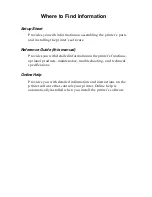
3
Select
Printers/Plotters
from the
Peripheral Devices
menu.
4
Select
Printers/Plotters
from the
Printers/Plotters
menu.
5
Select
Add a Remote Printer
from the
Actions
list,
then select a printer name.
Examples:
my_printer or printer1
6
Select a remote system name.
Example:
jetdirect1
(node name of the HP Jetdirect
print server)
7
Select a remote printer name.
Type
text
for ASCII or
raw
for PostScript, PCL, or HP-
GL/2.
8
Check for a remote printer on a BSD system. You must
type
Y
.
9
Click
OK
at the bottom of the menu. If the configuration
is successful, the program prints the message:
The printer has been added and is ready to
accept print requests.
10
Click
OK
and select
Exit
from the
List
menu.
11
Select
Exit Sam
.
Note
By default, the lpsched is not running. Make sure you
turn the scheduler on when you set up your print
queues.
Printing a Test File
To verify that the printer and print server connections are
correct, print a test file.
1
At the UNIX system prompt type:
lpr -Pprinter_name file_name
where
printer_name
is the designated printer and
file_name
refers to the file to be printed.
Examples
(for BSD-based systems):
Summary of Contents for jetdirect 250m
Page 12: ...Section 1 Networks Click the button to continue ...
Page 21: ...Section 2 Network Printing Click the button to continue ...
Page 28: ...Section 3 Installing a Network Printer Click the button to continue ...
Page 37: ...End of Network Basics tutorial ...
Page 82: ...Next topic Requirements ...
Page 99: ...Next topic Other links ...
Page 136: ...Next topic Using RARP ...
Page 194: ...Does the control panel display on your printer show an error message ...
Page 215: ...Does the page indicate I O Card Ready ...
Page 218: ......
Page 278: ...Australia This equipment complies with Australian EMC requirements Canada ...
Page 280: ......
















































